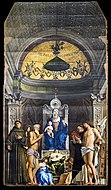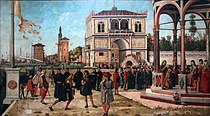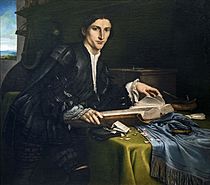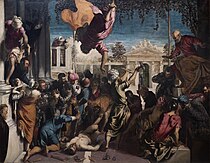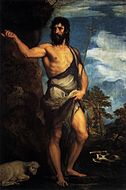Gallerie dell'Accademia
 Façade of the gallery on Campo della Carità | |
 Click the map for an interactive, fullscreen view. | |
| Established | 1750 |
|---|---|
| Location | Campo della Carità, Dorsoduro 1050, Venice, Italy |
| Coordinates | 45°25′53″N 12°19′41″E / 45.43139°N 12.32806°E |
| Type | Art Museum |
| Director | Giulio Manieri Elia |
| Curator |
|
| Public transit access | vaporetto |
| Website | gallerieaccademia |
The Gallerie dell'Accademia is a museum gallery of pre-19th-century art in Venice, northern Italy. It is housed in the Scuola della Carità on the south bank of the Grand Canal, within the sestiere of Dorsoduro. It was originally the gallery of the Accademia di Belle Arti di Venezia, the art academy of Venice, from which it became independent in 1879, and for which the Ponte dell'Accademia and the Accademia boat landing station for the vaporetto water bus are named. The two institutions remained in the same building until 2004, when the art school moved to the Ospedale degli Incurabili.
History
[edit]Early history
[edit]The Accademia di Belle Arti di Venezia was founded on 24 September 1750; the statute dates from 1756.[1] The first director was Giovanni Battista Piazzetta; Gianbattista Tiepolo became the first president after his return from Würzburg.[2]
It was one of the first institutions to study art restoration starting in 1777 with Pietro Edwards, and formalised by 1819 as a course.
In 1807 the academy was re-founded by Napoleonic decree. The name was changed from Veneta Academia di Pittura, Scultura e Architettura to Accademia Reale di Belle Arti, "royal academy of fine arts", and the academy was moved to the Palladian complex of the Scuola della Carità, where the Gallerie dell'Accademia are still housed. The collections of the Accademia were first opened to the public on 10 August 1817.[1][3]
Later history
[edit]The Gallerie dell'Accademia became independent from the Accademia di Belle Arti di Venezia in 1879. Like other state museums in Italy, it falls under the Ministero per i Beni e le Attività Culturali, the Italian Ministry of Culture and Heritage.
Building
[edit]The Napoleonic administration had disbanded many institutions in Venice including some churches, convents and Scuole. The Scuola della Carità, the Convento dei Canonici Lateranensi and the church of Santa Maria della Carità thus became the home of the Accademia. The Scuola della Carità was the oldest of the six Scuole Grandi and the building dates back to 1343, though the scuola was formed in 1260. The Convento dei Canonici Lateranensi was started in 1561 by Andrea Palladio, though it was never fully completed. The facade of Santa Maria della Carità was completed in 1441 by Bartolomeo Bon.
Collection
[edit]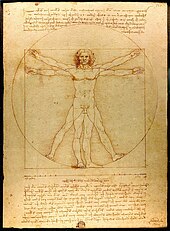
The Gallerie dell’Accademia contains masterpieces of Venetian painting up to the 19th century, generally arranged chronologically though some thematic displays are evident.
Artists represented include: Giovanni d'Alemagna, Jacopo and Leandro Bassano, Lazzaro Bastiani, Jacopo, Gentile and Giovanni Bellini, Bernardo Bellotto, Paris Bordone, Hieronymus Bosch, Canaletto, Antonio Canova, Vittore Carpaccio, Giulio Carpioni, Rosalba Carriera, Cima da Conegliano, Pietro da Cortona, Domenico Fetti, Jacobello del Fiore, Fra Galgario, Pietro Gaspari, Luca Giordano, Giovanni Antonio and Francesco Guardi, Giorgione, Francesco Hayez, Giulia Lama, Charles Le Brun, Johann Liss, Leonardo da Vinci, Pietro and Alessandro Longhi, Lorenzo Veneziano, Johann Carl Loth, Lorenzo Lotto, Francesco Maffei, Giovanni Mansueti, Andrea Mantegna, Rocco Marconi, Michele Marieschi, Hans Memling, Michele di Matteo da Bologna, Palma Vecchio and Giovane, Paolo Veneziano, Giovanni Battista Piazzetta, Piero della Francesca, Bonifacio de' Pitati, Giambattista Pittoni, Mattia Preti, Sebastiano and Marco Ricci, Benedetto Rusconi, Carlo Saraceni, Giovanni Battista and Giovanni Domenico Tiepolo, Jacopo and Domenico Tintoretto, Titian, Cosmè Tura, Paolo Veronese, Giorgio Vasari, Antonio, Bartolomeo and Alvise Vivarini, Giuseppe Zais, Francesco Zuccarelli.
The collection includes Leonardo da Vinci's drawing of the Vitruvian Man, which is displayed only rarely as the work, being on paper, is fragile and sensitive to light. In 2019, the Louvre in Paris requested the loan of the drawing for its exhibition of works by Leonardo. The request was refused by a cultural heritage group. A court tribunal in Venice, however, decided that the work would suffer no ill effects if shipped with great care and displayed under controlled conditions.[4] The work was, therefore, part of the Louvre's exhibition from 24 October 2019 to 24 February 2020.[5]
Highlights
[edit]-
Hieronymus Bosch
The Hermit Saints, 86 × 120 cm -
Jacopo Bassano
Adoration of the Shepherds, 9 × 142 cm -
Giovanni Bellini
Madonna and Child with Saint Catherine and Saint Mary Magdalene, 58 × 107 cm -
Giovanni Bellini
Martinengo Pietà, 65 × 90 cm -
Giovanni Bellini
San Giobbe Altarpiece, 371 × 258 cm -
Giovanni Bellini
Sacred Conversation, 54 × 76 cm -
Paris Bordone
The Presentation of the Ring, 370 × 301 cm -
Tintoretto, Presentation at the Temple
-
Canaletto
Perspective View with Portico, 131 × 93 cm -
Vittore Carpaccio
Cycle of St. Ursula, 297 × 527 cm -
Giorgione
Old Woman, 68 × 59 cm -
Giorgione
The Tempest, 82 × 73 cm -
Lorenzo Lotto
Gentleman in His Study, 98 × 116 cm -
Andrea Mantegna
St. George, 66 × 32 cm -
Piero della Francesca
St. Jerome and Donor, 49 × 42 cm -
Giambattista Pittoni
Penitent Magdalene, 48 × 38 cm -
Tintoretto
Lamentation, 227 × 294 cm -
Tintoretto
Resurrection -
Tintoretto
Miracle of the Slave, 415 × 541 cm -
Tintoretto
Saint Mark's Body Brought to Venice, 421 × 306 cm -
Tintoretto
Creation of the Animals, 151 × 258 cm -
Titian
Pietà, 353 × 348 cm -
Titian
Virgin and Child, 124 × 96 cm -
Titian. Saint John the Baptist, 201 × 134 cm
-
Titian
The Presentation of the Virgin, 345 × 775 cm -
Paolo Veronese
Battle of Lepanto, 169 × 137 cm -
Paolo Veronese
The Feast in the House of Levi, 555 × 1280 cm -
Paolo Veronese
Mystical Marriage of St Catherine, 337 × 241 cm -
Tintoretto, The Murder of Abel, 149×196 cm
See also
[edit]References
[edit]- ^ a b Accademia di belle arti di Venezia, 1750–2010. Cenni storici Archived 2013-11-13 at the Wayback Machine (in Italian). Accademia di belle arti di Venezia. Accessed July 2013.
- ^ Elisa Viola (2005). L'Accademia di Venezia: i maestri, le collezioni, le sedi (in Italian). Venezia: Marsilio. ISBN 9788831786553. p. 17.
- ^ Gallerie dell'Accademia: Storia delle collezioni Archived 2014-10-19 at the Wayback Machine (in Italian). Soprintendenza Speciale per il Patrimonio storico, artistico ed etnoantropologico e per il Polo Museale della città di Venezia e dei comuni della Gronda lagunare, 7 October 2009. Accessed July 2013.
- ^ "Leonardo's 'Vitruvian Man' Is Headed to the Louvre Despite Italian Scholars' Protests". Smithsonian. 21 October 2019. Retrieved 2 December 2019.
- ^ "Louvre exhibit has most da Vinci paintings ever assembled". The Atlantic. 1 December 2019. Retrieved 2 December 2019.
External links
[edit] Media related to Gallerie dell'Accademia (Venice) at Wikimedia Commons
Media related to Gallerie dell'Accademia (Venice) at Wikimedia Commons
| Preceded by Doge's Palace |
Venice landmarks Gallerie dell'Accademia |
Succeeded by Grand Canal |
- Gallerie dell'Accademia
- Buildings and structures completed in 1343
- Accademia di Belle Arti di Venezia
- Art museums and galleries in Venice
- Dorsoduro
- 1750 in art
- Art museums and galleries established in the 1750s
- Buildings and structures completed in 1750
- Educational organizations established in 1750
- 1750 establishments in the Republic of Venice
- Renaissance architecture in Venice





